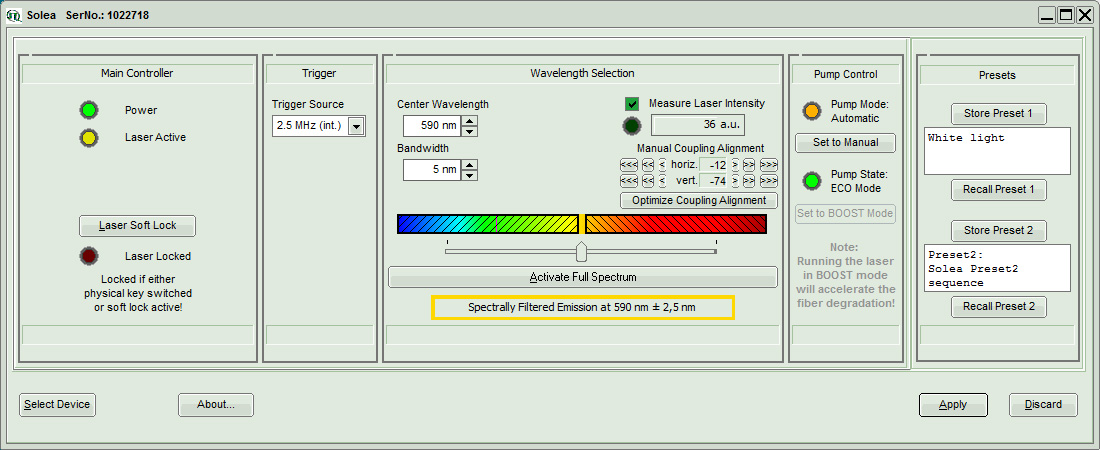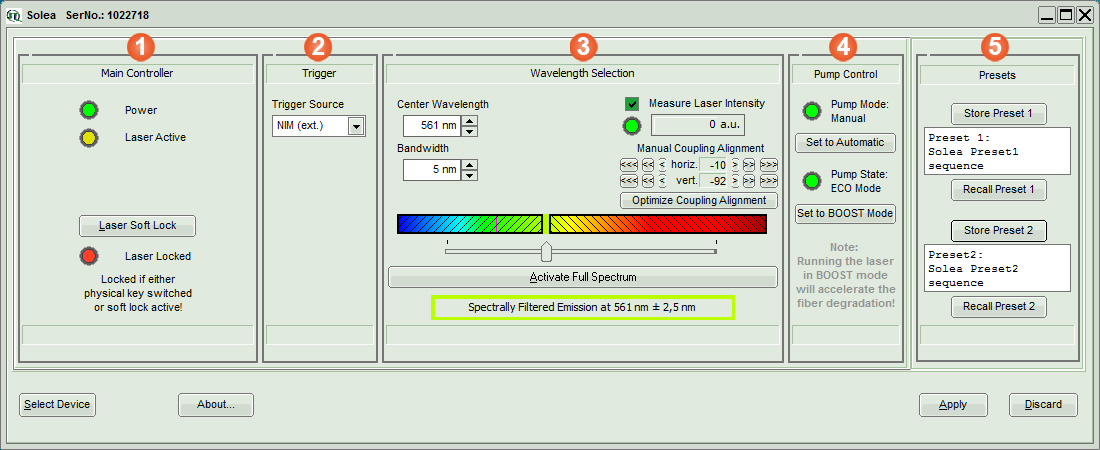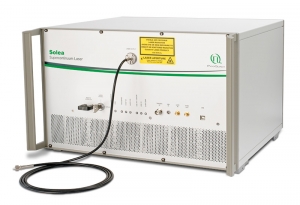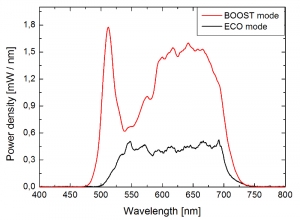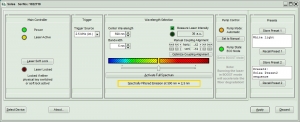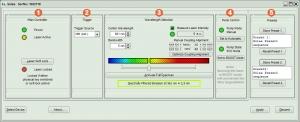Picosecond Pulsed Sources
Solea (discontinued)
Supercontinuum Laser
The Solea laser is discontinued as of October 2018.
- Extended spectral range: 525 - 900 nm (ECO mode), 480 - 900 nm (BOOST mode)
- Extended 2-year worldwide warranty*
- Supercontinuum output or wavelength selected output through built-in tunable bandpass filter
- Emission from a polarization maintaining singlemode fiber with FC/PC connector
- Externally triggerable 1 - 40 MHz
- Internal oscillator: 2.5 - 40 MHz (user selectable)
- Optimized timing/synchronization output for TCSPC or FLIM
- Supercontinuum average output power up to 250 mW (ECO mode) or 750 mW (BOOST mode) at 40 MHz repetition rate
- Average spectral output power after wavelength selector up to 1 mW / 5 nm (ECO mode) or up to 2.5 mW / 5 nm (BOOST mode) at 40 MHz repetition rate.
- Pulse width down to 90 ps (wavelength and power dependent)
*limited to 2000 hours of operation in BOOST mode for the fiber components
The Solea lasers are stand alone, computer controlled, supercontinuum laser sources with an unmatched flexibility in repetition rates. The lasers are available in four versions covering two possible spectral domains and either including a tunable bandpass filter for wavelength selection ("Solea", "SoleaR") or directly emitting the unfiltered supercontinuum spectrum ("Solea White", "SoleaR White").
All lasers emit from a polarization maintaining single-mode fiber with FC/PC connector. The Solea lasers are based on a unique combination of gain-switched, fiber-amplified laser diodes with exclusive patented fiber pumping control and a well established state-of-the-art photonic-crystal fiber for supercontinuum generation.
Full computer control via easy to use software
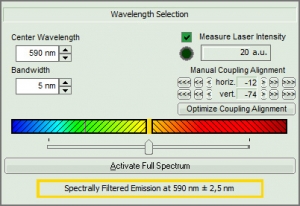 The Solea lasers are completely computer controlled by an easy-to-use graphical user interface (GUI) for Windows. The software allows to control pulse repetition rate, operation mode, as well as central wavelength and spectral width of the output. Different settings can be pre-defined and saved for an easy change of configurations. A library for custom programming is also provided and allows access to all functions of the Solea from, e.g., LabView or other programming languages.
The Solea lasers are completely computer controlled by an easy-to-use graphical user interface (GUI) for Windows. The software allows to control pulse repetition rate, operation mode, as well as central wavelength and spectral width of the output. Different settings can be pre-defined and saved for an easy change of configurations. A library for custom programming is also provided and allows access to all functions of the Solea from, e.g., LabView or other programming languages.
Variable repetition rates up to 40 MHz
A special feature of the Solea lasers is the capability to be operated at various freely adjustable repetition rates between 1 and 40 MHz. The repetition rates can be either selected using an internal oscillator, which provides six fixed user-selectable repetition rates between 2.5 and 40 MHz. Alternatively, the Solea lasers can even be externally triggered at any repetition rate between 1 and 40 MHz. This unique feature permits synchronization with other lasers for, e.g., multicolor excitation schemes. The extinction between each pulse is complete, classical contrast limited pulse pickers are not needed.
Easy wavelength selection
The emission wavelength selector for the Solea lasers is based on a tunable bandpass filter. The filter features a high side mode suppression ratio of greater than OD 5 (50 dB), which makes it even suitable for single molecule detection. The wavelength selector permits to set the central emission wavelength as well as the width of the spectral emission to any value between 3 and 15 nm. It can also be bypassed in order to have access to the available supercontinuum spectrum.
Polarized emission in the VIS down to 480 nm
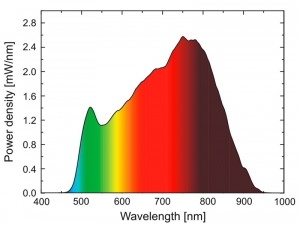 The Solea lasers emit from a polarization maintaining single-mode fiber and can be operated in two modes: ECO and BOOST. In ECO mode, the stress induced in the photonic-crystal fiber is lower than in the BOOST mode. In ECO mode, the SoleaR for example features a usable spectral range between 525 and 900 nm. The average spectral output of the supercontinuum reaches more than 250 mW after the emission fiber at 40 MHz repetition rate, which corresponds to an average spectral density of 0.4 mW/nm. After the emission wavelength selector an average output power of 1.0 mW at 40 MHz repetition rate is available for a 5 nm wide spectral bandwidth. The Solea can also be operated in BOOST mode, which extends the available spectral range down to 480 nm. The average spectral output of the supercontinuum then reaches more than 750 mW after the emission fiber at 40 MHz repetition rate, which corresponds to an average spectral density of 1.0 mW/nm. After the emission wavelength selector an average output power of 2.5 mW at 40 MHz repetition rate is available for a 5 nm wide spectral bandwidth.
The Solea lasers emit from a polarization maintaining single-mode fiber and can be operated in two modes: ECO and BOOST. In ECO mode, the stress induced in the photonic-crystal fiber is lower than in the BOOST mode. In ECO mode, the SoleaR for example features a usable spectral range between 525 and 900 nm. The average spectral output of the supercontinuum reaches more than 250 mW after the emission fiber at 40 MHz repetition rate, which corresponds to an average spectral density of 0.4 mW/nm. After the emission wavelength selector an average output power of 1.0 mW at 40 MHz repetition rate is available for a 5 nm wide spectral bandwidth. The Solea can also be operated in BOOST mode, which extends the available spectral range down to 480 nm. The average spectral output of the supercontinuum then reaches more than 750 mW after the emission fiber at 40 MHz repetition rate, which corresponds to an average spectral density of 1.0 mW/nm. After the emission wavelength selector an average output power of 2.5 mW at 40 MHz repetition rate is available for a 5 nm wide spectral bandwidth.
Pulse width down to 90 ps
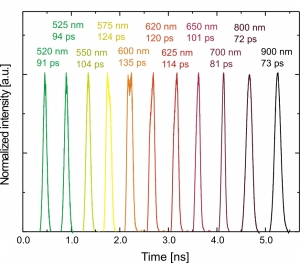 The output pulse width after the emission wavelength selector depends on the output power and selected emission wavelength. It is typically around 150 ps (FWHM) and can reach 90 ps (FWHM) for certain wavelengths. Each pulse is accompanied by a corresponding timing optimized synchronization signal, which can be used to trigger other components such as TCSPC electronics.
The output pulse width after the emission wavelength selector depends on the output power and selected emission wavelength. It is typically around 150 ps (FWHM) and can reach 90 ps (FWHM) for certain wavelengths. Each pulse is accompanied by a corresponding timing optimized synchronization signal, which can be used to trigger other components such as TCSPC electronics.
The Solea laser is discontinued as of October 2018.
Solea versions
| Solea | Solea White | SoleaR | SoleaR White | |
|---|---|---|---|---|
| Supercontinuum output |  |
 |
 |
 |
| Integrated emission wavelength selector |  |
 |
General specifications
| Optical output after emission fiber | ||||
|---|---|---|---|---|
| Solea, Solea White | SoleaR, SoleaR White | |||
| Spectral range (- 3 dB bandwidth) | 525 - 700 nm (ECO mode) 480 - 700 nm (BOOST mode) |
525 - 900 nm (ECO mode) 480 - 900 nm (BOOST mode) |
||
| Output fiber | polarization maintaining fiber with FC/PC connector and endcap, length: 3 m | polarization maintaining fiber with FC/PC connector and endcap, length: 3 m | ||
| Supercontinuum output | ||||
| Average output power @ 40 MHz repetition rate | > 100 mW (ECO mode) > 250 mW (BOOST mode) |
> 250 mW (ECO mode) > 750 mW (BOOST mode) |
||
| Average spectral power density @ 40 MHz repetition rate | 0.4 mW/nm (ECO mode) 1 mW/nm (BOOST mode) |
0.4 mW/nm (ECO mode) 1 mW/nm (BOOST mode) |
||
| Output after emission wavelength selector (not included in Solea White, SoleaR White) | ||||
| Bandwidth tunability | 3 - 15 nm (FWHM) | 3 - 15 nm (FWHM) | ||
| Average output power @ 40 MHz repetition rate | 1.0 mW (ECO mode, 5 nm bandwidth) 2.5 mW (BOOST mode, 5 nm bandwidth) |
1.0 mW (ECO mode, 5 nm bandwidth) 2.5 mW (BOOST mode, 5 nm bandwidth) |
||
| Pulse width (wavelength and output power dependent) | min. 90; typ. 150; max. 230 ps | min. 90; typ. 150; max. 230 ps | ||
| Repetition rates | ||||
| all Solea versions | ||||
| Internal | ||||
| Range | 2.5, 5, 10, 20, 40 MHz (user selectable) | |||
| External via NIM input | ||||
| Range | 1 - 40 MHz | |||
| Trigger level | fixed trigger level at - 400 mV | |||
| Connector | NIM-CAMAC | |||
| External via TTL input | ||||
| Range | 1 MHz - 40 MHz | |||
| Amplitude | - 5 to + 5 V (maximum limits) | |||
| Trigger level | adjustable between - 1 and + 1 V | |||
| Connector | BNC | |||
| Synchronization output | ||||
| Amplitude | < -800 mV into 50 Ohms (NIM) | |||
| Connector | SMA | |||
| Dimensions | ||||
| Base unit | 465 × 425 × 285 mm (w × d ×h) | |||
| Weight | 32.6 kg | |||
| Operation | ||||
| Operating system | WindowsTM 7 / 8 / 8.1 / 10 | |||
| PC interface | USB 2.0 | |||
| Temperature range | 10 – 35 °C | |||
| Maximum power consumption | 375 W | |||

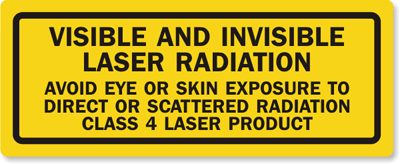
All Information given here is reliable to our best knowledge. However, no responsibility is assumed for possible inaccuracies or omissions. Specifications and external appearances are subject to change without notice.
The Solea laser is discontinued as of October 2018.
The control software of the Solea is based on a user friendly interface which allows to fully monitor the parameters of the device.
Different colour schemes (bright, dark or standard windows) are available and can be chosen with respect to the application and experimental environment. The dark scheme, for example, has been specially made for light sensitive experiments where light perturbation should be minimized.
Function modules
The user interface is structured in five thematical slots that control the core function modules of the device by simple mouse clicks.
- The Main Controller interface enables to lock and unlock the laser operation.
- The Trigger inferface allows to select an internal repetition rate or switch the Solea to external trigger input.
- The Wavelength Selection interface permits to set the central emission wavelength and the spectral bandwidth. Alternatively, the wavelength selector can also be bypassed, which gives access to the available supercontinuum emission. There are also controls allowing to optimize the laser output by adjusting the fiber coupling through motorized beam adjustment elements.
- The Pump Control interface permits to set the mode of operation of the Solea (ECO/BOOST, Auto/Manual).
- The Presets interface permits to save and recall any setting of the Solea (repetition rate, wavelength, bandwidth, etc.)
The Solea laser is discontinued as of October 2018.
Fluorescence lifetime measurements
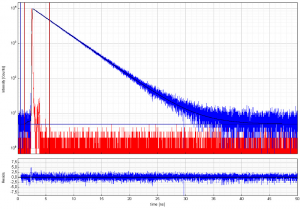 Fluorescence lifetime measurements of ATTO 555 in ethanol. The sample was excited at 550 nm using a spectral bandwidth of 5 nm and a repetition rate of 20 MHz. Data was collected using the TCSPC based spectrometer FluoTime 300. Data analysis using numerical reconvolution resulted in a single liftetime of 3.87 ns (χ2=1.07).
Fluorescence lifetime measurements of ATTO 555 in ethanol. The sample was excited at 550 nm using a spectral bandwidth of 5 nm and a repetition rate of 20 MHz. Data was collected using the TCSPC based spectrometer FluoTime 300. Data analysis using numerical reconvolution resulted in a single liftetime of 3.87 ns (χ2=1.07).
Fluorescence Correlation Spectroscopy (FCS)
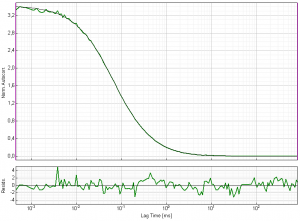 Fluorescence correlation spectroscopy (FCS) of ATTO 655 in water. The sample was excited at 630 nm using a spectral bandwidth of 5 nm and a repetition rate of 10 MHz. Data was collected using the confocal microscope MicroTime 200. The correlation curve can be nicely fitted and the amplitude of zero at long lag times proves the high stability of the laser output.
Fluorescence correlation spectroscopy (FCS) of ATTO 655 in water. The sample was excited at 630 nm using a spectral bandwidth of 5 nm and a repetition rate of 10 MHz. Data was collected using the confocal microscope MicroTime 200. The correlation curve can be nicely fitted and the amplitude of zero at long lag times proves the high stability of the laser output.
STED microscopy
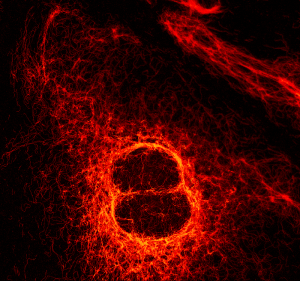 STED microscopy using the Solea laser for excitation. The image shows vimentin fibers stained with ATTO 565 via primary and secondary antibodies. A lateral resolution of approx. 50 nm is obtained, which can be expected for a fiber with a diameter of 10 nm, covered by antibodies with a diameter of approx. 8 nm each.
STED microscopy using the Solea laser for excitation. The image shows vimentin fibers stained with ATTO 565 via primary and secondary antibodies. A lateral resolution of approx. 50 nm is obtained, which can be expected for a fiber with a diameter of 10 nm, covered by antibodies with a diameter of approx. 8 nm each.
Data courtesy of J. Engelhardt and S.W. Hell, DKFZ Heidelberg, Germany
The Solea laser is discontinued as of October 2018.
The spercontinuum laser Solea can be used for various applications, where variable wavelengths with high and variable repetition rates are important, such as:
- Time-Resolved Fluorescence
- Fluorescence Lifetime Imaging (FLIM)
- Fluorescence Correlation Spectroscopy (FCS)
- Fluorescence Lifetime Correlation Spectroscopy (FLCS)
- Foerster Resonance Energy Transfer (FRET)
- Stimulated Emission Depletion Microscopy (STED)
- Pulsed Interleaved Excitation (PIE)
- Fluorescence Anisotropy (Polarization)
- Time-Resolved Photoluminescence (TRPL)
- TRPL Imaging
- Antibunching
- Single Molecule Spectroscopy / Detection
The Solea laser is discontinued as of October 2018.
The following documents are available for download:
Latest 10 publications referencing Solea
The following list is an extract of 10 recent publications from our bibliography that either bear reference or are releated to this product in some way. Do you miss your publication? If yes, we will be happy to include it in our bibliography. Please send an e-mail to info@picoquant.com containing the appropriate citation. Thank you very much in advance for your kind co-operation.


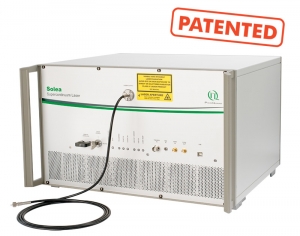
 Get in touch
Get in touch
